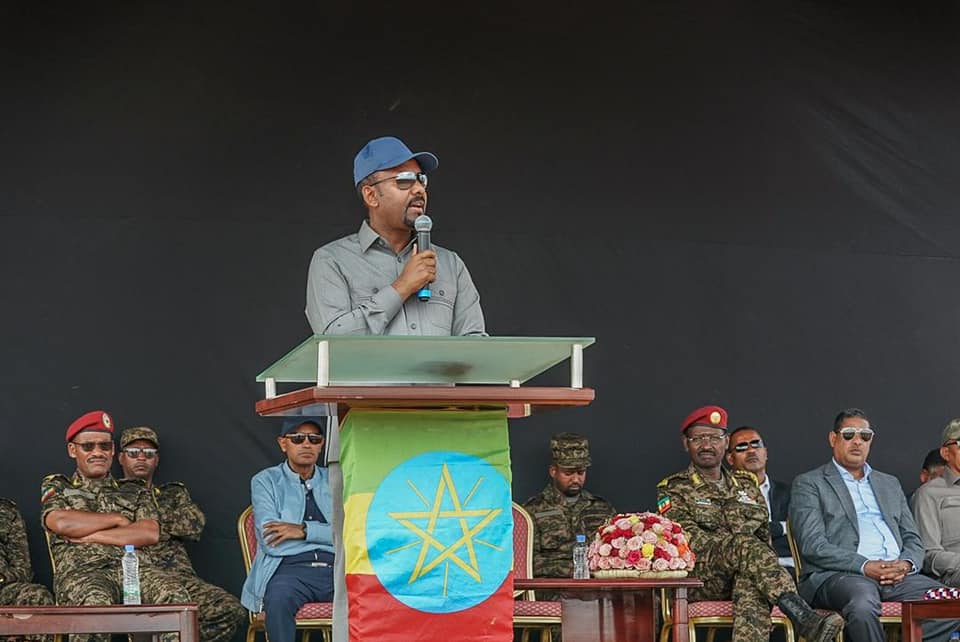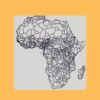BY MOHAMED KHEIR OMER on African arguments
Ethiopian PM Abiy Ahmed is grappling with a new rebellion in Amhara, simmering conflicts in several regions and a major economic crisis. His response? To take careful aim at his old pal, Isaias Afwerki.
Graphic courtesy: Zephania Alemu
The Amhara are not only the second largest ethnic group in Ethiopia comprising about 28 % (30 million) of the population; but their historical, cultural, religious, political, and economic significance makes them an integral part of the Ethiopian socio-political fabric. They occupy an important fertile geographical region; and for historical reasons, they are spread out more widely around the country than any other ethnic group. They have played a dominant role in the development of the country. Up to 1991 when the Derg fell and for some time after, they were overrepresented in the educational sector, civil service and the military at the national level and within state structures. Firearms have been in widespread use since the 16th century; militancy has long been a sine qua non of politics and ambition in the Amhara region. As such – and unlike the Tigray war and the insurgency in Oromia – the conflict in Amhara could have devastating consequences in unravelling the country.
Abiy’s main support base
Ethiopia’s Prime Minister Abiy Ahmed’s drew the bulk of his support from the Amhara during his first years in office. During the Tigray war, Abiy mobilized their intellectual, military, religious, artistic, linguistic, and economic resources, coupled with a vibrant media in the diaspora. Responding to a call by Abiy, militias were trained and organised with the Amhara state special forces. For many Amhara intellectuals, Abiy Ahmed was a messianic figure sent to dismantle their bitter enemy, the TPLF. The Amhara hoped to regain territory they believe was unjustly seized from them during the 27-year TPLF-dominated EPRDF rule. Amhara militias were also used in the war against the Oromo Liberation Front, aggravating the potential conflict between the two most populous regions. Both the Amhara and the Eritrean regime that supports them felt betrayed by Abiy, after Abiy signed a peace agreement with the TPLF in November 2022 and started disarming the Amhara forces. Both Amhara and Eritrea want the TPLF finished off. The Amhara militia are determined not to give up the regions – called Wolkait-Tegede by Amhara and western Tigray by the Tigrayans – they had retaken during the Tigray war. If the TPLF regains that region, it will gain access to Sudan, a scenario which the Eritreans regard as threatening.
The Eritrean connection
The involvement of the Eritrean regime in the Amhara region conflict echoes wider regional tensions. Eritrea’s Isaias Afwerki allegedly backs the Amhara with training and arms, according to internal military sources. Welations between Eritrea and Ethiopia rapidly deteriorating, Abiy’s jingoism on the issue of Ethiopia’s right to a seaport may well lead to open warfare.
Abiy recently told Ethiopia’s parliament that the country has legitimate rights to the Red Sea. The Eritrean government gave a muted response. The antagonistic rhetoric between the Eritrean and Ethiopian regimes has been on the rise in the past two years. Behind closed doors, Abiy is alleged to have said that he will crush the Eritrean regime and bring back not only the Port of Assab but the whole of Eritrea into Ethiopia. Ethiopia’s chief of staff is reported to have said, “We need to designate Eritrea as an enemy.” An Eritrean Facebook page associated with Eritrea’s intelligence has stated that Abiy is leading a government that is on the verge of collapse, with a weak army that is unable to fight the FANO militants, and a country that is eating itself like a cancer. Getachew Reda, one of the leaders of the TPLF had predicted in 2021 that Abiy’s next war will be with Eritrea. The Amhara conflict could likely result in a new war between the two countries, with destructive consequences for the whole region.
Within the context of the Sudan conflict, Isaias is openly supporting the Sudanese Armed Forces (SAF) led by Al Burhan over the Rapid Support Forces (SAF) led by Hemedti. He invited 41 representatives from the Democratic Bloc of the Forces of Freedom and Change, a splinter faction that supports Al Burhan, in mid-September, to witness the signing of the Asmara Declaration.
Close relations with Sudan’s army give Isaias leverage in assisting the Amhara, even through Sudan’s border. Abiy is supported by the UAE and according to informed sources, he supports the RSF.
Genuine grievances
Fighting in the Amhara region is the culmination of grievances dating back to 1991. The Amhara have genuine grievances against the state. Hundreds of Amhara have been killed, injured, and displaced, mostly in Oromia and Benishangul Gumuz Regional State, since Abiy took power. Since the military confrontation between the Amhara militia (Fano) erupted in April this year, hundreds of Amhara have been arrested indiscriminately including National and regional MPs for suspicion that they support the militants. Even before the clashes, Amhara had been banned from entering Addis Ababa. Amhara regard the Oromo as their major competitor for power and resources, replacing the TPLF, and view the current conflict as a confrontation with an Oromo-dominated state, even though the regime practises widespread repression in Oromia and suffers general hostility among Oromo.
From its inception, the Amhara have been wary of ethnic federalism, weakening their political, economic, and cultural hegemony, as they are treated like second-class citizens in non-Amhara regional states. Since the promulgation of the 1995 federal constitution that codified ethnic federalism, the Amhara have struggled to come to terms with their loss of historical privileges. Ironically it was Walelegn Mekonen, an Amhara, university student leader, who was among the first to write about nations and nationalities in Ethiopia, The Amhara feel they lost many privileges after 1991.
A region at war with itself

Ethiopia PM, Abiy Ahmed Ali at a military passing-out parade in August 2023. Eritrean intelligence considers his army “too weak…to fight the FANO militants”. Photo courtesy: Abiy Ahmed Ali.
Since Abiy assumed power in 2018, the Amhara region stands out from all other regional states as the only one in which several high-ranking officials were killed, including a president, an Amhara PP chief, a security chief, police commissioners, at least four Bureau chiefs, several district administrators, and several junior officials. If the conflict continues, those killings may target senior national officials. The killings continue unabated.
The region is also accused of orchestrating a coup against its government. The region has had six presidents in five years; Abiy frequently reshuffles them, deploying those he does not trust to federal institutions outside Amhara, replacing them with loyalists. Many Amhara see this as a deliberate strategy to prevent strong Amhara leadership capable of addressing people’s needs and challenging the Oromo regional Prosperity Party.
Economic consequences
The previous civil war in Tigray and the bordering states cost the country $28.7bn. The Amhara region is also a popular tourist attraction area and accounts for 22% of the national Gross Domestic Product (GDP). The losses incurred due to the recent conflict in the region is estimated at 2.5 billion birr ($ 45 million). Flower, vegetable, and fruit cultivation and marketing were the most hard-hit investments. In the fiscal year just ended, the regional government invested 464 million birr ($ 8,4 million) in revitalizing defunct industries. Those investments may be at risk. Amhara region is also one of the major breadbaskets of the country. It produces 39% of the stable crop, Teff. With WFP suspension of food aid in the country due to food diversion, and with people dying of hunger in Tigray and other areas, the conflict will further jeopardize food security.
The Fano
The Fano, the Amhara militia fighting the government are no match for the Ethiopian army. They lack a central command structure, and are poorly armed, even though Eritrea supports and trains them. They committed crimes against humanity in Tigray. However, they are popular in the region. Some Amhara may not see them as their representative, but all are unified in their grievances against the state. The Fano have withdrawn from the big cities they occupied, not through fighting but by defection of their supporters in the regional government, early in the fighting. However, clashes continue in the outskirts of towns and countryside and regularly ambush federal troops.
Urgent need for peace
The region has a high number of firearms, and a culture and history of militancy, and is suitable for guerilla warfare. With Amarigna the country’s lingua franca, prominent artists promoting the Amhara cause, Amhara federal officials leaking state secrets, a well-organised diaspora financing the rebellion, , and Eritrea’s alleged involvement, PM Abiy is confronted with a formidable new enemy. It is also unclear how long the large number of Amhara army officials and soldiers in the ENDF, the national army, will continue to kill their kinsmen. Added to these threats, the risk of escalating Amhara-Oromo tensions gives the conflict a major destabilising effect on the Ethiopian state. It does not help that the Abiy government is struggling to manage an economic polycrisis: the losses incurred from the Tigray war, the the lingering undertow of COVID and the global economic recession. There is an urgent need to resolve this conflict peacefully. As the Forum for Social Studies in Ethiopia presented three possible scenarios for the country, the worst being the disintegration of the country into separate units. It is not beyond the realm of possibility.
This article was published on African arguments: https://africanarguments.org/2023/10/will-the-amhara-rebellion-unravel-the-ethiopian-state/

